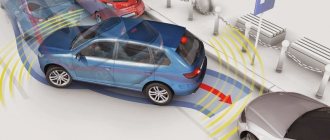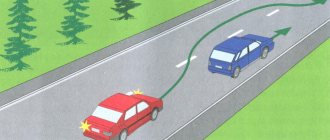Home / Vehicles
Back
Published: 05/20/2020
Reading time: 9 min
0
757
– I live in an old-style apartment building. And we often have a problem with parking - in the evenings we have to look for a place. And some cunning residents park their cars right next to the entrance to the entrance and are very in the way! Are there any legal ways to deal with them?
– Parking of personal vehicles near the entrance of a residential building is prohibited, as this may cause inconvenience to residents of the entrance due to the need to bypass the parked vehicle.
However, you can park vehicles, including personal large ones, in a temporary parking lot - for example, to load things or pick up and drop off passengers, that is, if the car ends up near the entrance for a short time.
- What legal norms are violated when parking near the entrance?
- Is it possible to determine the parking procedure in the local area at a meeting of building residents?
- Where can I complain about a parking violation?
- Measures to be taken against the violator
Parking rules in a residential area
The traffic rules have only 2 rules governing parking in a residential area. Firstly, parking with the engine running is prohibited (to prevent exhaust smoke from entering the apartments). Secondly, parking of category “C” freight vehicles is prohibited. This is all established by clause 17.3, however, in addition to this, the traffic rules have general parking rules that prohibit parking a car on the lawn and on the sidewalk unless there is an appropriate sign nearby that allows such parking.
But parking rules in a residential area are regulated not only by traffic regulations. The Russian Federation has fire safety and sanitary standards, which all citizens must also comply with.
Fire safety standards require that cars be parked so as not to block the entry into the yard for special service vehicles.
And SanPiN 2.2.1/2.1.1.1200-03 establishes the following restrictions on parking near the house:
- parking for 10 cars can be located at a distance of up to 10m from the windows/entrance to the house;
- at a distance of 11-50m from the windows/entrance to the house, parking for 15 cars can be located;
- at a distance of 51-100 m from the windows/entrance to the house, parking for 25 cars can be located;
- at a distance of 101-300 meters from the windows/entrance to the house, parking for 35 cars can be located;
- At a distance of more than 300m from the windows/entrance to the house, parking for 50 cars can be located.
Possible fines for illegal parking
Fines for illegal parking can be completely different, as they depend on the type of offense:
- parking on the sidewalk - 1000 rub. (in Moscow and St. Petersburg - 3000 rub.);
- creating obstacles to the movement of other vehicles - 2000 rubles (in Moscow and St. Petersburg - 3000 rubles);
- creating obstacles for a fire truck or ambulance - 500-2000 rubles. (if people died or were injured because of the obstacle, then you can also receive criminal punishment);
- parking on the lawn - up to 5000 rub. depending on the region (the fine is set by the regional Code of Administrative Offences);
- parking near garbage containers - up to 5000 rubles. depending on the region (the fine is set by the regional Code of Administrative Offences);
- creation of an illegal parking space with fences – RUR 5,000.
Tow truck payment
A fine is not the only thing that awaits an illegally parked driver. If a parked car interferes with vehicles or pedestrians, traffic police officers can send it to the impound lot. For the evacuation itself and for each day the vehicle is kept in the parking lot, the driver will have to pay a fairly large amount. More details about the rules and cost of evacuation, as well as impound parking tariffs, can be found in a separate article “Fine for evacuation of a car.”
The meaning of the word "entrance"
entrance
1. action according to the meaning of ch. drive up, drive up; approaching something on any ground transport ◆ Each of us had a yearning heart beating intensely in our chest, as always happens when approaching
to his home, left since childhood. A. A. Avdeev, “Diary”, 1945 (quote from NKRY)
2. place, path along which one approaches something ◆ Approaching home in the most cheerful mood, Levin heard a bell from the side of the main entrance
To home.
L.N. Tolstoy, “Anna Karenina”, 1878 ◆ At the very entrance
, on the sides of the steps, lay two large clay lions.
E. A. Salias, “On Moscow”, 1880 (quote from NKRY) ◆ Of course, the entrance
to the river should be paved, that’s for sure, - well, somehow... D. N. Mamin-Sibiryak, “ Bread”, 1895 ◆ At the
entrance
to Sevastopol there is a checkpoint in the village of Verkhnesadovy.
Yulia Gutova, “Motherland and Motherland” // “Russian Reporter”, 2014 (quote from NKRY) ◆ The expansion of the parking lot and entrances
to the service center is intended to increase the throughput capacity of the territory. “Official dealers” (2002) // “Autopilot”, August 15, 2002 (quote from NKRY)
3. the entrance (usually covered) to the building, as well as the internal part of the building adjacent to the entrance, in which the stairs, landings, elevator, etc. are located. ◆ Several years ago, a doctor could not enter the entrance
- There was a dog standing at
the entrance
. Elena Maslova, “Sometimes providing assistance is life-threatening” (2003) // “Meeting” (Dubna)”, April 9, 2003 (quote from NCRY)
4. decompression residents of apartments facing this part of the building ◆ To popularize sports, Fetisov proposed creating a TV channel, citing as justification a story about his own driver - on the days of the Davis Cup final the entire entrance
was forced to gather in the small apartment of the only happy owner of NTV-Plus. Ekaterina Grigorieva, “The President is looking for a sports incentive” // Izvestia, 2002 (quote from NKRY)
5. willing. a method of bird hunting in which, while camouflaging, they drive up as close as possible to the target ◆ Only when shooting from the entrance
the dog interferes with a large and watchful bird sitting on the ground, and not in the trees, because the bird is afraid of it〈…〉 S. T. Aksakov, “Notes of a rifle hunter of the Orenburg province”, 1852 ◆ I don’t remember which date, but on one very frosty day, Mikhaila and I went to
the entrance
to look for hazel grouse - and imagine our surprise when, instead of hazel grouse, we noticed a lurking wolf in a heap of buckwheat straw. A. A. Cherkasov, “Zerentui”, 1883–1887 (quote from NKRY)
6. outdated small reconnaissance detachment, military patrol
7. history in Ancient Rus'
- the right of the feudal lord or his representative (entry) to come to the feudal’s possessions for the purpose of collecting rent ◆ Vladyka Ivan sent Archpriest Timofey to Pskov, during Shrovetide week, to
the entrance
. 1st Pskov Chronicle, “Tikhanovsky list”
Fight against violators
The traffic police do not patrol the yards, so the problem with parking violators will not be solved by itself. Of course, residents themselves can take illegal measures (scratch the body, damage the tires, and so on), unfortunately, quite often this is exactly what happens. But these methods can lead to an even greater aggravation of the conflict, and if the pest is caught, then to problems with the law.
It is much more effective to deal with a violator within the framework of the law. To do this, citizens have 4 ways:
- Call the traffic police.
- Submitting a written application.
- Filing a complaint via the Internet.
- Filing a complaint through the application.
The simplest method of punishment is to call the traffic police directly to your yard. Another advantage of this method is that the violator will not only be fined, but also have the car towed. But this method also has a rather significant disadvantage - you will have to wait quite a long time for the traffic police officers; perhaps during this time the offender will have time to remove his car. You can call inspectors by calling the general number 102 or by calling the number of the duty station in your area.
A written complaint is submitted to the traffic police department. It is drawn up in free form, but must have evidence - photographs, which must clearly depict the violation itself and clearly show state registration numbers.
A more convenient option for filing a complaint is using the Internet. You can complain about a violator both through the official website of the traffic police and through special applications for smartphones: “Moscow Assistant” - for residents of the capital, Spot - for residents of the regions. Any of these methods speeds up the process of filing a complaint and relieves the citizen of the need to visit traffic police departments. But filing an online complaint should also not be groundless: it must be accompanied by photographs or videos that prove the fact of the violation and clearly display the vehicle’s license plate number.
Demolition of parking barriers in the yard
Another problem that can be caused by unscrupulous neighbors is the installation of illegal parking barriers. Brazen violators install various posts, chains, and fences in the yard, thereby “reserving” a parking space. Such actions are also illegal.
There are several ways to combat this:
- Get rid of barriers yourself. If they are installed on public property illegally, then any resident has every right to dismantle them themselves. At the same time, it is important not to damage the road surface yourself, so as not to later be guilty of damaging public property. It is also worth thinking about possible personal problems with the parking space invader.
- Contact the local police officer. If a car is parked in a legally created parking space, and the problem is only a fence that prevents other residents from using the parking lot, then the traffic police will be powerless. In this case, citizens can call the local police officer or write a statement. It will be his responsibility to stop the violation and punish the culprit.
- Contact the Criminal Code. Management companies are also authorized to demolish illegal structures, and many companies will do this much faster than the police. However, everything depends on the company itself: managers of prestigious residential complexes quickly deal with violators, and ordinary housing and communal services may require the preparation of a collective complaint, delaying the process in the hope that the problem will be solved by itself. Another drawback of this method: the Criminal Code cannot punish the violator; its powers only include getting rid of the illegal fence.
- Contact the city administration. The last method is the longest; It is worth using it only if other methods have not brought any results. The city administration will consider the complaint for a month. As a result, she may oblige the Criminal Code to demolish the fence, and instruct the police to impose a fine on the violator. In this case, both the Criminal Code and the district police officer will definitely stop being inactive.
“No parking” signs appeared in the courtyards. Is this even legal?
Residents of Moscow and the Moscow region have begun to more often encounter a situation where they arrive in their yard and encounter a sign prohibiting not only parking there, but even stopping. Users of social networks do not understand whether they can appeal the fines they received near their entrances.
Autonews.ru figured out who is prohibiting parking and why, whether it is legal, how to find out about the ban being introduced in advance and what to do if such a sign is placed in your yard.
Who can prohibit parking in the yard?
On Moscow roads, signs can be installed by the Traffic Management Center (TCOC), district governments or territory balance holders. As for courtyards, as the head of the ONF working group “Protection of the Rights of Motorists” and coordinator of the Blue Bucket Society movement Pyotr Shkumatov explained, the management company can install signs here - but only if the territory is marked as a courtyard.
Sometimes the signs are also installed by the developer. In mid-November, residents of one of the new buildings in the 17th microdistrict of Zelenograd complained that a sign prohibiting parking appeared in their yard, and local media clarified that it was installed by the company PIK, i.e. developer. Residents have big questions about the appearance of such signs, because it is unclear who and on what basis will fine motorists if they do park within the sign’s coverage area.
How to April 28, 2021 Yards are fined and evacuated. How to avoid problems
News November 14, 2021 Motorists complained about the ban on parking in courtyards
Is it legal to put a sign in the yard?
Lawyer Orest Matsala, in an interview with Autonews.ru, said that it is legal to install signs 3.27 “Parking/stopping is prohibited” in courtyards. But at the same time, the sign must be facing the drivers, and it must be clearly visible, and most importantly, its installation must be preceded by the approval of the traffic management project. If there is such a project, then the installation of the sign has been agreed upon, and therefore the fines that will come for non-compliance with these rules are legal.
The peculiarity of the situation is that the territory prohibited for parking can be classified as the property of the owners of the apartment building. In this case, according to auto lawyer Anna Kukleva, the decision to install the sign should be made by the owners. Otherwise, the parking ban will be considered illegal and may be appealed.
If the territory on which the sign is located and on which it prohibits leaving a car belongs to the city, then the coordination and approval of the installation of the sign takes place through the Data Center.
Where to park in the yard?
And at the end of the article about methods of dealing with parking violators, I would like to provide a list of permitted parking methods:
- Equipped parking in the yard. This is the most obvious and most preferred option. If free parking in the yard is available, then it is better to leave the car there, and not try to park right at the entrance to the entrance. Unfortunately, such parking is often not enough to accommodate all of the residents' vehicles.
- Paid parking for residents of the house. Some residential complexes sell not only apartments, but also separate parking spaces in the yard. Thus, part of the parking lot becomes private: the number of the car for which the space is intended is indicated on the asphalt, and at the request of the owner of the parking space, the management company itself can install legal barriers.
- Paid garages or parking lots. The main disadvantage of this method is the distance from housing. In addition, the car owner will have to pay for parking. However, this method also has an advantage: paid parking lots are guarded and under video surveillance, which means the driver does not have to worry about the safety of his property. If the parking lot is indoors, then in winter it has another advantage: the car does not have to be dug out from under the snow and warmed up.
About parking at the entrance
The traffic rules have a whole section devoted to the rules of stopping and parking in various places. Parking in courtyards and at entrances is regulated by traffic rules in residential areas.
The yard area is the space located in front of a residential building. Usually there are children's play areas or places for recreation, as well as pedestrian paths and passages for vehicles. Unlike a residential area, such an area is not marked with any sign. This can cause difficulties for drivers, since certain vehicle traffic regulations apply in yards. The main ones are speed limits and pedestrian priority.
The traffic rules also contain a list of vehicles that are prohibited from parking at the entrances of residential buildings:
- machines with the engine running for more than 5 minutes. An exception to this clause are situations when any cargo needs to be loaded into or unloaded from the vehicle. It is also allowed to extend the parking time with an active motor if passengers are boarding or disembarking;
- trucks weighing more than 3.5 tons.











